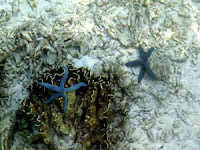Lankayan is part of the 460 square kilometer Sugud Islands Marine Conservation Area, a beautiful environment of small islands ringed by coral sand beaches, seagrass beds, shallow sandy flats and numerous coral reefs. The island rests in the middle of sea turtle and whale shark migration routes and is just a 1.5-hour boat ride from Sandakan.
There are 23 bungalows on the island, all are beachfront and within a few steps of a pristine coral reef. Admittedly, this was a higher-end stay than we would have normally considered, but it was quite the ‘Adventure in Traveling’ and the experience outweighed the cost.
The jetty at Lankayan
The trip from Sandakan over the open Sulu Sea can be choppy, but you’ll get plenty of fresh air. The boat arrives at the dive house, about 100 meters away from the beach at the end of a long jetty. If you don’t have dive or snorkeling equipment, you can borrow it here, but you’ll be required to leave a small cash deposit. This is also where all dive trips start and end.
In our experience, one can best explore a coral reef in water less than 10 meters deep, so we prefer to snorkel rather than scuba dive. With the reef just meters away from our bungalow, we were able to enjoy it at leisure, sunbathing on the beach whenever we were tired of swimming.

The colors of the reef are brilliant, and the varied and numerous species that inhabit the area are staggering. In one hour we saw black-tipped shark, moray eel, cuddle fish, scorpion fish and a Hawksbill sea turtle, as well as numerous different species of triggerfish, parrotfish, coral and so much more.
There is a resident biologist on the island. Her primary concern is to protect the eggs of the Green and Hawksbill sea turtles that nest on the island, but she will also help you identify any species living on the reef. There are patrols on the island that watch for new turtle nests. When discovered, she removes the eggs and takes them to a hatchery for protection. On our second night, we were able to accompany a clutch of hatchlings for their release.
If you’ve been exploring the region for a while, Lankayan is a great place to break from your adventures for a few worry free days. Since equipment is readily available on the island, there is no need to carry masks, fins and snorkels on the rest of your travels. Just bring a good sunscreen.

































